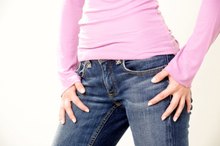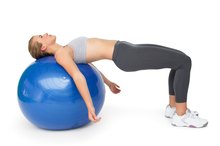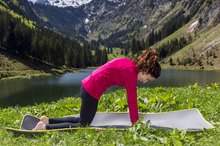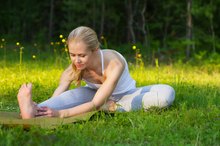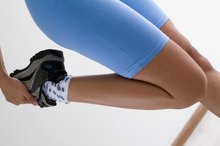Physical Therapy for a Broken Tailbone
The tailbone, called the coccyx, is the last three to five vertebraes at the bottom of the spine. Injury to the tailbone may occur when a person falls backwards, or during childbirth. A broken tailbone causes intense pain that may last for months or years. Some relief from pain may be achieved through the use of physical therapy exercises.
Squats
Bodyweight squats can relieve the pressure on the coccyx and can build muscle strength in the thighs and glutes. Stand with your feet hip-width apart. Your toes should be slightly turned out. Hold your arms straight out in front of you for balance. Slowly bend your knees and sit back as if you are about to sit on a chair. Keep your heels on the floor and bend until your knees are over your toes. Pause, then slowly return to the starting position. Do one to two sets of 12 to 15 repetitions.
Pelvic Lock
Pelvis Circulation Exercises
Learn More
Also called the Mula Bandha or root lock, the pelvic lock involves contracting the muscles in the pelvic floor. This is the same contraction you do to hold in urine. Pelvic lock exercises serve to stimulate nerves, increase blood flow and improve muscular health in the sacral region. Tighten those muscles as hard as you can and hold for at least 10 seconds. Release, then repeat. Slowly increase the length of time you hold the contraction. Do these exercises at least three times a day.
Cat/Cow Stretch
The cat/cow stretch stretches the spinal muscles as it stimulates the nerves, improves blood flow, and relieves pain in the back and neck. Put yourself in a face-down table-top position with your wrists under your shoulders and your knees under your hips. Inhale and curl your toes under, drop your belly, and lift your head slightly up so that you are looking at the ceiling. Start the movement at your tailbone and progess up the spine so the last thing in position is your neck. Hold a second, then exhale as you release your feet back to the starting position, lift your belly up and round your spine, and drop your head. Repeat five to 10 times.
Spinal Twist
Exercises to Increase Hip Size
Learn More
This stretch releases pressure from the lower spine and improves blood flow to the area. Lie on your back on the floor or a bed. Extend your arms out to your sides. Keep your right leg straight on the floor. Bend your left leg and bring it up and across your body, so that your knee is at hip height. Keep your shoulders flat on the floor. Hold for 8 to 10 seconds, then repeat on the other side. Do one to two sets of three repetitions.
Related Articles
References
Writer Bio
Rick Rockwell is a self-employed personal trainer and experienced freelance writer. His articles have been published throughout the Internet. He has more than eight years of experience as a certified personal trainer, group fitness instructor and lifestyle coach. His company, Rockwell Fitness, is dedicated to educating and empowering others to live healthy lifestyles.
